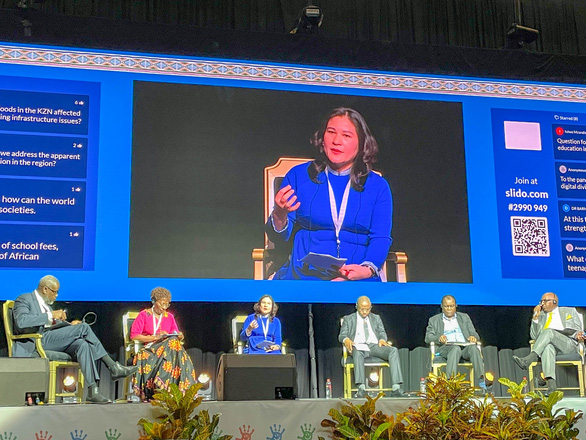Deputy Minister of Labor, War Invalids, and Social Affairs Nguyen Thi Ha shared Vietnam’s plans to eradicate child labor at a conference in South Africa on Tuesday.
At the fifth Global Conference on the Elimination of Child Labor in Durban, South Africa, Ha spoke about the pivotal role that childhood education plays in reducing the risk of children leaving school to find work.
Currently, about 94.4 percent of Vietnamese children have access to education thanks to government policies to make primary and secondary education compulsory, eradicate illiteracy, and reduce or exempt tuition fees for poor, disabled, ethnic minority, and underprivileged children.
The Vietnamese government also has policies which help these marginalized groups gain access to health insurance and other social welfare programs.
Currently, Vietnam is cooperating with other entities, such as the United Nations International Children’s Emergency Fund (UNICEF) and the International Labor Organization (ILO) to develop programs that create jobs for families and support children who at high risk of becoming child laborers.
To mitigate the effects of the COVID-19 pandemic, the Vietnamese government launched the program 'Waves and Computers for Children' – an initiative which mobilizes private resources to expand Internet coverage in rural areas and provide computers for poor and migrant children.
|
|
| Deputy Minister of Labor, War Invalids, and Social Affairs Nguyen Thi Ha speaks at fifth Global Conference on the Elimination of Child Labor in Durban, South Africa, May 17, 2022. Photo: H.Minh / Tuoi Tre |
The initiative also aimed to flexibly combine online learning throughout the COVID-19 pandemic and bring students back to school.
“For the long term, Vietnam has launched a national program on poverty alleviation, job creation, and vocational training for young laborers, as well as relief packages for economic recovery, which paid much attention to disadvantaged people,” Deputy Minister Ha said.
The deputy minister called for further cooperation to improve the quality of general education and vocational orientation and training, thereby creating sustainable careers for young Vietnamese people and gradually eliminating child labor.
At the conference, the Vietnamese delegation offered solutions to improve the quality of education and increase access to education for children, especially those from marginalized communities who are at high risk of becoming child laborers, Dang Hoa Nam, director of the Department of Child Affairs under the Ministry of Labor, War Invalids, and Social Affairs, told press agencies.
“Education is an important key to breaking the poverty cycle, which is the origin of child labor,” Nam said.
A national survey on child labor conducted in 2018 and released in December 2020 by the ministry and the General Statistics Office showed that more than 1.7 million children nationwide participated in economic activities and over one million of them fit the definition of 'child laborers.'
Half of child laborers were found to have worked in dangerous and hazardous conditions.
However, Vietnam’s child labor rate was two percentage points lower than the average in the Asia-Pacific region.
Up to 84 percent of child laborers in Vietnam live in rural areas and over half of them work in the agro-forestry-fishery sector.
Some 40.5 percent of children engaged in child labor were unpaid family workers.
Like us on Facebook or follow us on Twitter to get the latest news about Vietnam!





















































